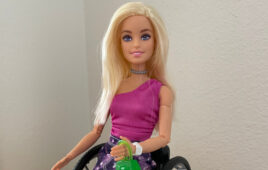Highly motivated, gainfully employed, active, working to sustain good health practices. That’s the way that Penny J. Powers, PT, MS, ATP, at the Vanderbilt University Adult Seating & Mobility Clinic described client Anne Richardson, a part-time employee at Vanderbilt’s Divinity school library.
“She is a wife, mother and grandmother,” Penny added. “She is highly motivated to achieve the maximum level of independence with regards to mobility.”
Penny listed Anne’s clinical challenges: “Small-fiber peripheral neuropathy with neuropathic pain involving both lower extremities; osteoarthritis; impaired sensation in bilateral lower extremities; pain in upper extremities, wrists and hands resulting in functional impairments.”
Those impairments were significant, Penny added: “A history of falls; paresthesias; diminished ability to ambulate with and without assistive device secondary to the inability to weight bear (stand); decreased ability to propel a standard-weight or high-strength lightweight manual wheelchair.”
Penny said Anne “can independently self-propel an ultralightweight manual wheelchair with bilateral upper extremities and some foot propulsion.” But when in the community, Anne has relied on dependent mobility.

 and 17.5″ (back seat-to-floor height).</p>
<h4>Fine-Tuning the System</h4>
<p>Why the TiLite Aero Z? “The patient prefers and requested a foldingframe wheelchair,” Penny explained. “This folding manual wheelchair offers the best ‘retro’ fit for the SmartDrive attachment for folding chairs. It is the lightest-weight folding manual wheelchair that we could offer her.”</p>
<p>The Aero Z is set up with 2° camber, 80° hangers, composite adjustable footplates, adjustable-tension back upholstery, a Comfort Company Curve cushion, push-to-lock wheel locks, an adjustable quick-release axle, and plastic-coated handrims. Anne’s Aero Z does not have armrests.</p>
<p>Adding the MAX Mobility SmartDrive power-assist unit expanded the geography within Anne’s reach.</p>
<p>Using the SmartDrive “provides her with means to access the community for service and leisure activities, family activities and the university campus for employment-related duties and responsibilities,” Penny reports. “[Anne] verbalizes a high degree of satisfaction with the new manual wheelchair and recognizes that proficiency with the SmartDrive will take practice in a variety of settings, surfaces and terrains. She has met her goal of independent mobility in the community.”</p>
<p>And as for what the seating & mobility team learned from this experience?</p>
<p>“It is vital,” Penny says, “to keep abreast of innovations in the industry to be able to offer patients/clients optimum interventions to meet their goals and expectations.”</p>
<div class=)
